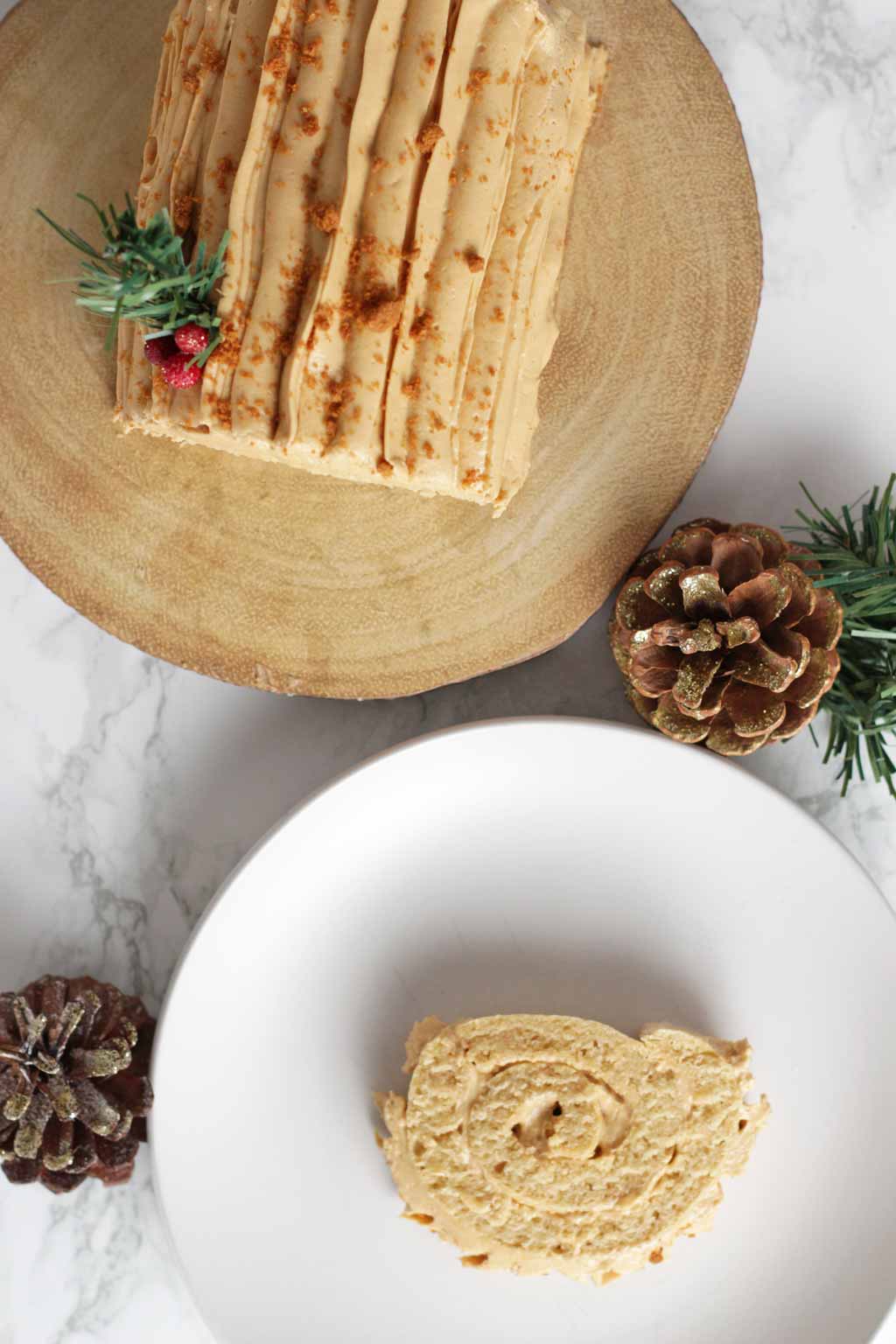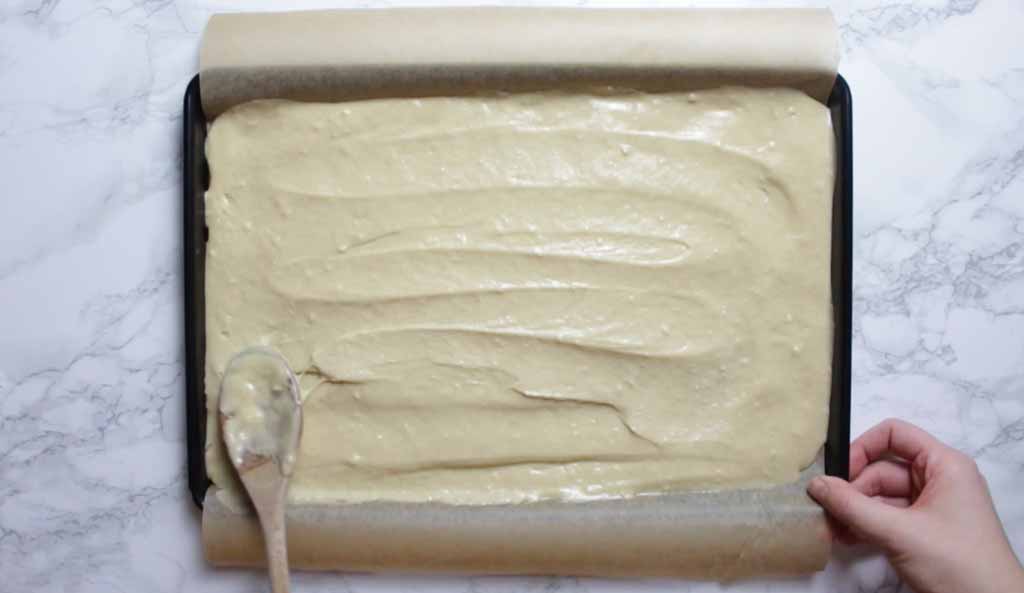Biscoff Yule Log
This Lotus Biscoff yule log is a perfect vegan alternative to the chocolate version for Christmas dessert. A sweetly spiced vanilla sponge rolled and covered in Biscoff icing!

After the success (finally) of my chocolate yule log, it was only natural that I made it again in another flavour.
And what better flavour to bake with than Biscoff?!
My Biscoff cake has been hugely popular since I made it back in February and this Biscoff yule log tastes very similar to that.
I think this will be a show stopper for Christmas dessert, and it’s a great alternative for those who are allergic to or don’t like chocolate.
Want more Biscoff desserts? Try these:
How to make a Biscoff yule log
Step 1:
Before you begin, preheat your oven to 180C/350F. If you’re using a fan or convection oven, the temperature you need is 160C/325F.
Line a 10 x 14″ or swiss roll tray with baking paper. I purchased mine in-store from Dunelm but it’s not available online so here is a link to an identical one from MasterClass.
Step 2:
The first part of this recipe is the vanilla sponge.
In a large bowl, mix together 200g of self-raising flour, 1/4 teaspoon of baking soda, 1/2 teaspoon of ground cinnamon (double if you want a stronger flavour) and 1/8 teaspoon of xanthan gum.
Xanthan gum isn’t totally essential for this recipe but I’d highly recommend it to prevent cracks when you roll the cake.
Make sure you measure it accurately with a measuring spoon as too much with make the batter too thick to spread.
Step 3:
Next, add 115g of caster sugar and stir it in.
Step 4:
Now it’s time for the liquid ingredients.
To the bowl, add 250ml of soy milk, 75g of melted vegan margarine, 2 teaspoons of vanilla extract and 1/2 a teaspoon of apple cider vinegar.
Give it a good mix, making sure to get any dry bits from the bottom of the bowl.
If you don’t have apple cider vinegar, you can substitute it with lemon juice or white vinegar.

Step 5:
Transfer the cake batter into your lined tray and gently spread it out with the back of your spoon or an offset spatula.
It will be slightly thicker than a regular cake batter. Make sure that it’s spread out very evenly to minimise cracking after baking.

Pop it in the oven and bake for 12 minutes.
Step 6:
While the cake is baking, lay a clean dishcloth/tea towel out and dust it with caster sugar. This will stop the cake from sticking to it.
Step 7:
Once the cake is done, gently tip it out onto the dishcloth. You want to do this while the cake is still hot but it’s OK to leave it cool for 5 minutes so you can handle it without burning yourself.
Remove the baking paper and sprinkle over some more caster sugar. Cut off any uneven or rough edges with a knife.
Step 8:
Carefully roll the cake up with the dishcloth inside and let it cool for 90 minutes.

For the Biscoff icing
This icing will go inside the cake and I used it on the outside too. If you want a bit of a contrast, you could use dark chocolate ganache on the outside instead.
Step 1:
Place 120g of vegan margarine into a large bowl. Using an electric mixer, mix for 10-20 seconds until it becomes soft and fluffy.
Step 2:
Add 125g of smooth Biscoff spread to the bowl and whisk again.
Step 3:
Measure out 250g of icing/powdered sugar.
Add half of it to the bowl and mix it in using a wooden spoon. Add the other half and repeat.
Step 4:
Add 2 tablespoons of soy milk and mix in gently.
Give it another mix with the electric mixer until it becomes pale, soft and fluffy.
Assembly
Step 1:
After the 90 minutes are up, very carefully unroll the cake. If you get any cracks, don’t worry as they can be covered up with the icing.
Step 2:
Use half of the Biscoff icing and spread an even layer all across the cake. Carefully roll it back up, this time without the dishcloth.

Cover the rest of the icing in the meantime and leave it at room temperature so it doesn’t become hard.
Cover the cake with plastic wrap and put it in the fridge for 1 hour. This will help it to hold its shape and will make your slices cleaner.
Step 3:
After 1 hour, remove the cake from the fridge.
Transfer the rest of the icing to a piping bag with a large star nozzle. Pipe vertical lines across the log until it’s all covered.

Sprinkle over Biscoff cookie crumbs while the icing is still wet.
Step 4:
Place it in the fridge for another hour to set and enjoy! I decorated mine with an artificial berry and greenery for a pop of colour.
FAQ:
Store it in the fridge with a cover over it.
This one is best enjoyed within 48 hours. It’ll be edible for a few more days afterwards but will begin to get soggy after the first 2 days.
I haven’t frozen this recipe myself yet but I imagine that it would be fine. It’s very similar to my Biscoff cake recipe which freezes well.
To freeze, place it in an airtight container and freeze for up to 2 months. To defrost, let it sit at room temperature for a few hours until thawed.

That’s all for now. I hope you enjoy this Biscoff Yule log! If you make it at home, please let me know how you get on by leaving a comment below. Happy baking! xo

Biscoff Yule Log (Vegan-Friendly)
Cinnamon and vanilla sponge rolled and covered with Biscoff icing.
Ingredients
- 200 g Self-raising flour
- ¼ Teaspoon Baking soda (bicarbonate)
- ½ Teaspoon Ground cinnamon (or use 1 teaspoon for a stronger flavour)
- ⅛ Teaspoon Xanthan gum (helps to prevent cracking, be careful not to use too much)
- 115 g Caster sugar
- 75 g Vegan margarine, melted after measuring
- 250 ml Soy milk
- 2 Teaspoons Vanilla extract
- ½ Teaspoon Apple cider vinegar (sub white vinegar or lemon juice)
For the icing:
- 120 g Vegan margarine
- 125 g Smooth Biscoff spread
- 250 g Icing/powdered sugar
- 2 Tablespoons Soy milk
To top:
- 1 Biscoff biscuit, crushed into crumbs
Instructions
-
Preheat your oven to 180°C/350°F (160°C/325°F if using a fan or convection oven). Line a 10 x 14" tray or swiss roll tin with baking paper.
-
In a large bowl, mix together the flour, baking soda, cinnamon and xanthan gum. Stir in the sugar.
-
Add the soy milk, vegan margarine, vanilla and vinegar. Stir thoroughly until you have a smooth cake batter.
-
Transfer it to your lined baking tray and spread it out very evenly. This will be a bit harder as the batter is thicker than a usual cake mix, but even spreading is very important to prevent cracking later on.
-
Bake for 12 minutes.
-
While the cake is baking, dust a clean dishcloth (teatowel) with caster sugar.
-
Remove the cake from the oven and let it sit at room temperature for 5 minutes so it cools enough to handle.
-
After 5 minutes, carefully tip the cake face down onto the dishcloth. Gently peel off the baking paper then sprinkle some more caster sugar onto the cake. This will prevent it from sticking to itself.
-
Cut off any rough or uneven edges using a knife.
-
Very carefully roll the cake up with the dishcloth inside. Let it sit at room temperature for 90 minutes to cool.
For the icing:
-
In a large bowl, whisk the margarine until soft and fluffy. I used an electric hand mixer to do this.
-
Add in the Biscoff spread and whisk again.
-
Add in half of the sugar and mix it in using a wooden spoon. Repeat with the other half.
-
Add the soy milk and give it another whisk until pale and fluffy.
Assembly:
-
After the 90 minutes are up, very gently unroll the cake. Use around half of the icing and spread over an even layer.
-
Carefully re-roll the cake, this time without the dishcloth inside. Don't worry if you get a few small cracks as these can be covered.
-
Cover the log in plastic wrap and place it in the fridge for 1 hour. This will help it to hold its shape.
-
Transfer the rest of the icing to a piping bag with a large star nozzle. Pipe vertical lines over the log until it's all covered. Alternatively, spread the icing on with a spatula and use a fork to create texture.
-
Sprinkle over the Biscoff crumbs.
-
Place in the fridge for 1 more hour to set before enjoying.
Recipe Notes
- Store covered in the fridge and eat within 2 days.



